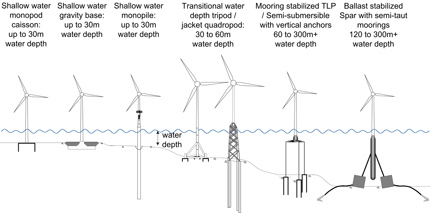How is sound used to research wind energy?
Wind energy is increasingly being used as an alternative energy source. As wind turbines have moved from land into ocean waters, sound is being used to find the best location for offshore wind farms. The potential effects on the environment and marine life of the sound generated by the construction and operation of wind farms also need to be considered when siting wind turbines.
When selecting a location for an offshore wind farm, the water depth and seafloor characteristics need to be evaluated. The type of wind turbine determines the water depth that is acceptable for its placement. Stationary wind turbines are usually located in water depths of less than 20 meters, whereas floating wind turbines can be placed in depths over 200 meters. Water depth is most often measured with underwater acoustics, using equipment such as an echosounder.

Water depth is an important consideration when constructing an offshore wind turbine. As water depth increases, different types of foundations are needed for a stable wind turbine. Figure credit: J. Schneider after NREL.
Seafloor characteristics determine how difficult it would be to construct a wind farm at that location. In regions where there is little sediment over the bedrock extensive drilling is required to install wind turbines, whereas pile driving for turbine installations is easier in areas where the sediment layer is deeper. Underwater acoustics is used to map and characterize ocean sediments, using equipment such as multibeam echosounders and side scan sonars.
Construction and operation of offshore wind farms create unwanted sound or noise. How much this noise will contribute to the existing ambient noise in a region is an important area of research. Dr. Jim Miller at the University of Rhode Island has measured the existing sound field off Block Island, Rhode Island, the proposed location of an offshore wind farm. Using measurements of the noise from one turbine in an offshore wind farm off Sweden, he estimated the amount of noise the proposed wind farm would add to the ambient noise off Block Island (for more information, please see the Advanced Topic on Noise Budgets). To learn more about this research, please visit the podcast at: https://coseenow.net/podcast/tag/alternative-energy/.
There is also the concern of the potential effects of the construction and operation of wind farms on marine life. While construction operations are very loud and may temporarily affect marine animals, long-term increases in ambient noise due to the operation of a wind farms could cause masking that might affect feeding and reproduction. Measurements of the noise from the pile-driving construction of a wind farm off Scotland estimated that bottlenose dolphins would experience auditory injury within 100 m and behavioral reactions at distances of up to 50 km from the wind turbines[1]Bailey, H., Senior, B., Simmons, D., Rusin, J., Picken, G., & Thompson, P. M. (2010). Assessing underwater noise levels during pile-driving at an offshore windfarm and its potential effects on marine mammals. Marine Pollution Bulletin, 60(6), 888–897. https://doi.org/10.1016/j.marpolbul.2010.01.003. Harbor porpoises have been shown to decrease their echolocation activity during construction[2]Carstensen, J., Henriksen, O., & Teilmann, J. (2006). Impacts of offshore wind farm construction on harbour porpoises: acoustic monitoring of echolocation activity using porpoise detectors (T-PODs). Marine Ecology Progress Series, 321, 295–308. https://doi.org/10.3354/meps321295. Harbor porpoises were also masked by operational noise when sound levels were at 128 dB at 0.7, 1.0, and 2.0 kHz, but not at sound levels of 115 dB[3]Lucke, K., Lepper, P. A., Hoeve, B., Everaarts, E., van Elk, N., & Siebert, U. (2007). Perception of low-frequency acoustic signals by a harbour porpoise (<I>Phocoena phocoena</I>) in the presence of simulated offshore wind turbine noise. Aquatic Mammals, 33(1), 55–68. https://doi.org/10.1578/AM.33.1.2007.55. It is believed that harbor porpoises would hear operational noise at distances of 20 to 70 m, whereas harbor seals would hear operational noise at less than 100 m up to several kilometers[4]Tougaard, J., Henriksen, O. D., & Miller, L. A. (2009). Underwater noise from three types of offshore wind turbines: Estimation of impact zones for harbor porpoises and harbor seals. The Journal of the Acoustical Society of America, 125(6), 3766–3773. https://doi.org/10.1121/1.3117444. More studies on the effects of wind farms are needed, particularly as new turbines are designed.
Additional Links on DOSITS
- Behavioral Changes
- Scientist Gallery – Dr. Jim Miller
- Echosounder
- How is sound used to measure water depth?
- Masking
- Multibeam Echosounder
- Ocean Noise Variability and Noise Budgets
- Side Scan Sonar
References
- Miller, J. H., Potty, G. R., Vigness-Raposa, K. J., Casagrande, D., Miller, L. A., Nystuen, J. A., … Clark, J. G. (2012). Environmental Assessment of Offshore Wind Power Generation: Effect on a Noise Budget. In A. N. Popper & A. Hawkins (Eds.), The Effects of Noise on Aquatic Life (Vol. 730, pp. 519–522). New York, NY: Springer New York. https://doi.org/10.1007/978-1-4419-7311-5_118
Cited References
| ⇡1 | Bailey, H., Senior, B., Simmons, D., Rusin, J., Picken, G., & Thompson, P. M. (2010). Assessing underwater noise levels during pile-driving at an offshore windfarm and its potential effects on marine mammals. Marine Pollution Bulletin, 60(6), 888–897. https://doi.org/10.1016/j.marpolbul.2010.01.003 |
|---|---|
| ⇡2 | Carstensen, J., Henriksen, O., & Teilmann, J. (2006). Impacts of offshore wind farm construction on harbour porpoises: acoustic monitoring of echolocation activity using porpoise detectors (T-PODs). Marine Ecology Progress Series, 321, 295–308. https://doi.org/10.3354/meps321295 |
| ⇡3 | Lucke, K., Lepper, P. A., Hoeve, B., Everaarts, E., van Elk, N., & Siebert, U. (2007). Perception of low-frequency acoustic signals by a harbour porpoise (<I>Phocoena phocoena</I>) in the presence of simulated offshore wind turbine noise. Aquatic Mammals, 33(1), 55–68. https://doi.org/10.1578/AM.33.1.2007.55 |
| ⇡4 | Tougaard, J., Henriksen, O. D., & Miller, L. A. (2009). Underwater noise from three types of offshore wind turbines: Estimation of impact zones for harbor porpoises and harbor seals. The Journal of the Acoustical Society of America, 125(6), 3766–3773. https://doi.org/10.1121/1.3117444 |